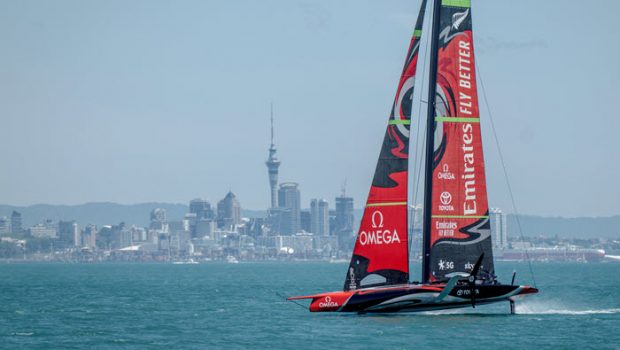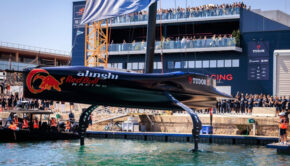America’s Cup: How techie are you?
Published on December 11th, 2019
by Mike Taggett
Most of us have a basic understanding of power. Walking upstairs takes a certain level of effort, but when we add a large sack of potatoes to the shoulder it takes more energy.
Power is commonly measured in watts. Variables here but riding a bike at a leisurely 15 mph on a flat windless road is something like 50 watts of effort. Riding at 35 mph would be in the 200 watt range. A horsepower is 745 watts. An elite cyclist can average 300 watts or more for a few hours. An elite sprinter can hit 1500 watts for 10 seconds or so. You get the idea.
I am a long time America’s Cup fan, and after having gone out with Paul Cayard a few times on America One (IACC), I was a bit shocked how the overhead of the hull had such a large amount of mechanical equipment for driving the winches, many shafts, transmissions, 90 degree gear boxes, etc.
But for the 36th America’s Cup, most of the systems on the new AC75 are now hydraulically driven, so I decided to reach out to Dan Bernasconi, Head of Design at Team New Zealand, to educate us America’s Cup energy/power nerds and yachties:
My understanding is that the foil arms are electro/hydraulic. Can you please tell us some specifics of the motor driving the hydraulic pump?
It is a single 15kW (20 HP) motor powering a pump which either drives directly or into an accumulator.
What is the energy in the battery pack in kilowatt hours (kWh)? Voltage?
It is a Torqueedo battery, 48V, 5kWh (5000 watts output for one hour, 500 watts for 10 hours, etc.)
Is there a combustion engine for backup or charging?
No
What is the basic size of the main hydraulic arms in diameter and actuated length?
Cylinder bore 100mm. Piston diameter 80mm. 780mm stroke.
How long to cycle from full down to full up?
Three seconds from normal sailing position to full-up (using the accumulator).
What is the weight of each arm/foil?
Each foil weighs 1385kg (3053 lbs.) of which 464kg (1023 lbs.) is the one-design foil arm.
If the battery and system fails, can the grinders switch over the hydraulics to power the arms manually?
No.
Can the arms drop with gravity alone to fully down?
Yes.
Do the grinders have any control on the amount of hydraulic fluid they are pumping via a valve or is it a fixed load/flow rate?
Grinders typically have lots of control over how they supply power, but this is different for each team.
I assume they pump fluid into a hydraulic accumulator which would keep the fluid pressurized, is that correct? If so, is it spring or gas pressure providing the fluid pressure?
The Rule permits use of a small (2.0 litres) accumulator which would typically use gas pressure.
What is the nominal operating pressure for the arms?
It is 350bar (5076 psi).
For the grinder based systems?
Up to 600bar (8700 psi).
How many gallons of hydraulic fluid are on board?
Approximately 20 liters, but varies for each team.
Are the valves that power winches, etc. purely mechanical or are they electro-mechanical and controlled with switches by the trimmers?
Winches can be mechanically connected to grinding pedestals, but hydraulic functions are controlled by electro-mechanical valves operated by trimmers and grinders.
I would think the current grinders use a watt meter when training. What is an average rate, say for 30 minutes continuous?
It is 300W per grinder as an average but much more in peaks.
It doesn’t seem the foil arms/boards can be tilted fore and aft? Is there any flight control in this manner?
Correct, the foils cannot be raked/tilted, but the foil wings have flaps which can be controlled, like on an aircraft.
Same with rudder/foil?
No, the whole rudder can be raked fore/aft.
In addition to Challenges from Italy, USA, and Great Britain that were accepted during the initial entry period (January 1 to June 30, 2018), eight additional Notices of Challenge were received by the late entry deadline on November 30, 2018. Of those eight submittals, entries from Malta, USA, and the Netherlands were also accepted. Here’s the list:
Defender:
• Emirates Team New Zealand (NZL)
Challengers:
• Luna Rossa (ITA) – Challenger of Record
• American Magic (USA)
• INEOS Team UK (GBR)
• Malta Altus Challenge (MLT) – WITHDRAW
• Stars + Stripes Team USA (USA)
• DutchSail (NED) – WITHDRAW
Of the three late entries, only Stars+Stripes USA remains committed, but they still must complete the entry fee payment process before they will be eligible to race. They have already paid their initial payment but as a late entry challenger under the Protocol they also have a liability to pay a US$1million late entry fee due in installments by October 1, 2019. This deadline coincided with the venue schedule which has the construction of their team base beginning in late 2019, which we assume was done in the event the team is unable to fulfill their payment deadline. However, it is not yet confirmed if they have paid the fee.
Key America’s Cup dates:
✔ September 28, 2017: 36th America’s Cup Protocol released
✔ November 30, 2017: AC75 Class concepts released to key stakeholders
✔ January 1, 2018: Entries for Challengers open
✔ March 31, 2018: AC75 Class Rule published
✔ June 30, 2018: Entries for Challengers close
✔ August 31, 2018: Location of the America’s Cup Match and The PRADA Cup confirmed
✔ August 31, 2018: Specific race course area confirmed
✔ November 30, 2018: Late entries deadline
✔ March 31, 2019: Boat 1 can be launched (DELAYED)
✔ 2nd half of 2019: 2 x America’s Cup World Series events (CANCELLED)
October 1, 2019: US$1million late entry fee deadline (NOT KNOWN)
February 1, 2020: Boat 2 can be launched
April 23-26, 2020: First America’s Cup World Series event in Cagliari, Sardinia.
During 2020: 3 x America’s Cup World Series events
December 10-20, 2020: America’s Cup Christmas Race
January and February 2021: The PRADA Cup Challenger Selection Series
March 2021: The America’s Cup Match
AC75 launch dates:
September 6 – Emirates Team New Zealand (NZL), Boat 1
September 10 – American Magic (USA), Boat 1; actual launch date earlier but not released
October 2 – Luna Rossa (ITA), Boat 1
October 4 – INEOS Team UK (GBR), Boat 1
Details: www.americascup.com









 We’ll keep your information safe.
We’ll keep your information safe.